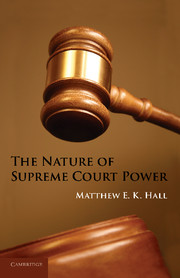Book contents
- Frontmatter
- Contents
- List of Figures
- List of Tables
- Preface
- 1 Neither Force, Nor Will
- 2 When Courts Command
- 3 Judging the Court
- 4 Popular Vertical Issues
- 5 Unpopular Vertical Issues
- 6 Popular Lateral Issues
- 7 Unpopular Lateral Issues
- 8 Neither the Sword nor the Purse, but the Keys
- Appendix I Case Selection
- Appendix II Survey Information and Citations
- Appendix III Supporting Data for Figures
- Appendix IV Statistical Analysis on the Effects of the Pico Ruling
- Appendix V Behavior Conformity Calculations
- Appendix VI Statistical Analysis of Behavior Conformity
- Appendix VII The Effects of Unanimity on Behavior Conformity
- Case References
- References
- Index
Appendix VII - The Effects of Unanimity on Behavior Conformity
Published online by Cambridge University Press: 06 December 2010
- Frontmatter
- Contents
- List of Figures
- List of Tables
- Preface
- 1 Neither Force, Nor Will
- 2 When Courts Command
- 3 Judging the Court
- 4 Popular Vertical Issues
- 5 Unpopular Vertical Issues
- 6 Popular Lateral Issues
- 7 Unpopular Lateral Issues
- 8 Neither the Sword nor the Purse, but the Keys
- Appendix I Case Selection
- Appendix II Survey Information and Citations
- Appendix III Supporting Data for Figures
- Appendix IV Statistical Analysis on the Effects of the Pico Ruling
- Appendix V Behavior Conformity Calculations
- Appendix VI Statistical Analysis of Behavior Conformity
- Appendix VII The Effects of Unanimity on Behavior Conformity
- Case References
- References
- Index
Summary
Some scholars have suggested that the Supreme Court may wield greater influence when the justices are more united in their rulings. The Court may be most powerful when it issues unanimous rulings and least powerful when the Court is sharply divided. This expectation is inconsistent with my theory of Supreme Court power because the divisions on the Court are unrelated to the institutional context of the ruling and the popularity of the ruling. Nonetheless, in this appendix I test the relationship between unanimity on the Court and behavior conformity to the Court's rulings in order to test this alternate theory.
To test this relationship, I repeat the analysis conducted in Appendix VI and add a new independent variable, # of Dissenters, to the regression analysis. The # of Dissenters variable is coded as the number of justices who dissented from the critical Supreme Court ruling studied in each issue area (i.e., the # of Dissenters variable is coded as a 2 for the abortion issue area because there were two dissenting justices in Roe v. Wade). Table A7.1 reports the results of regressing conservative and generous estimates of behavior conformity on the # of Dissenters with and without controls for the institutional context and popularity of the ruling. A negative coefficient for # of Dissenters would indicate that more unanimity on the Court is associated with greater behavior conformity; however, the coefficient for # of Dissenters is not statistically significant, nor is the sign in the expected direction in any of the regression models reported in the table.
- Type
- Chapter
- Information
- The Nature of Supreme Court Power , pp. 225 - 226Publisher: Cambridge University PressPrint publication year: 2010



